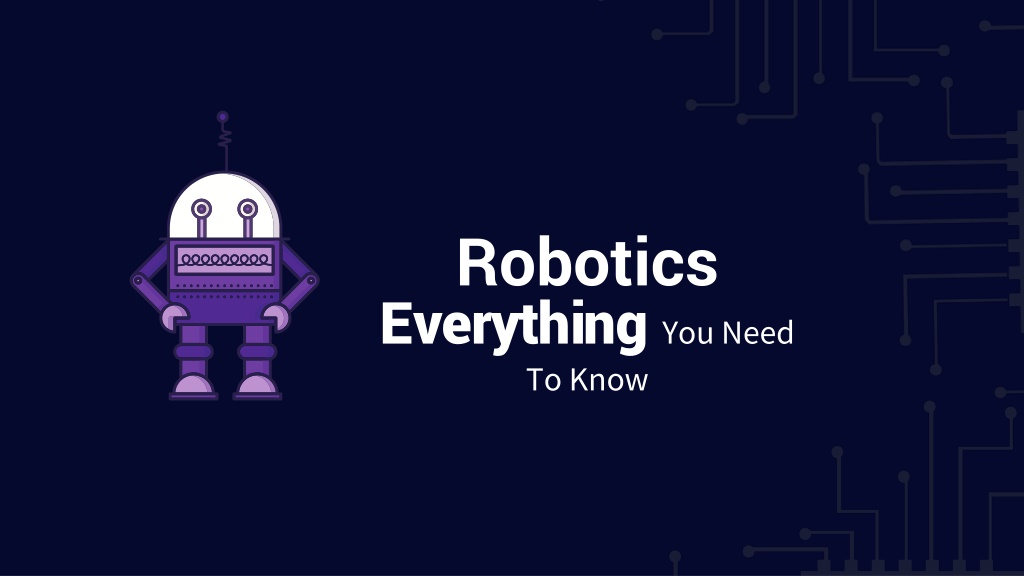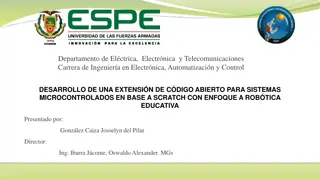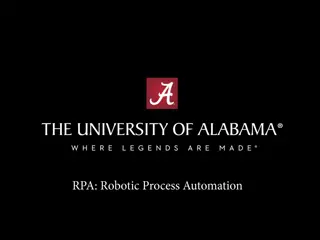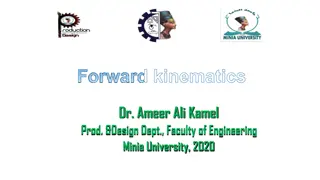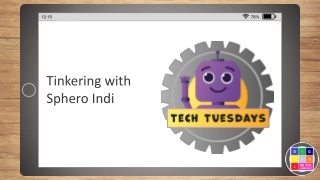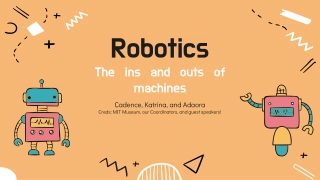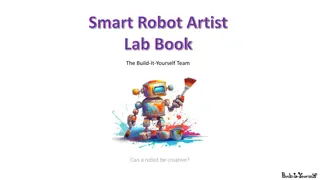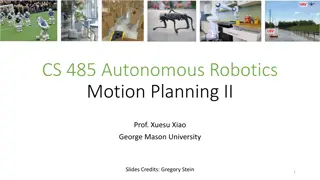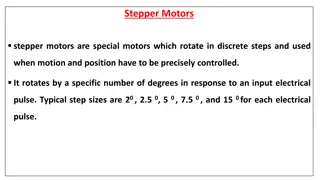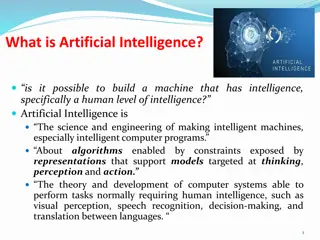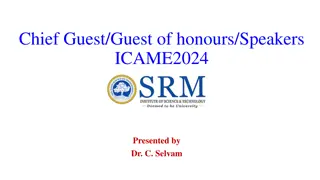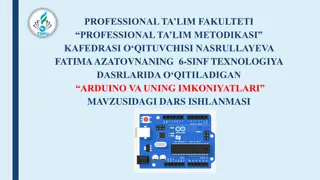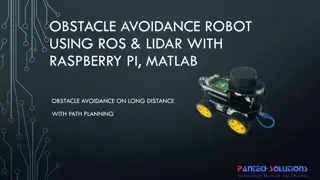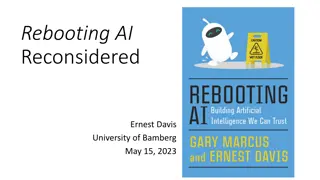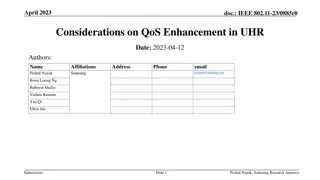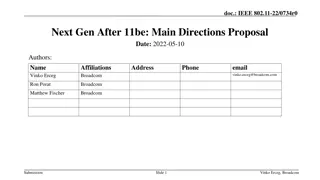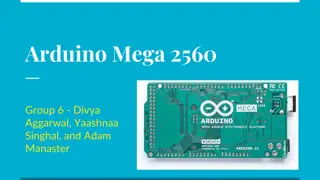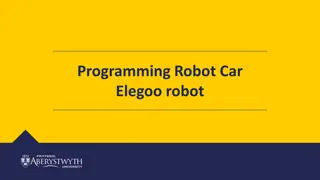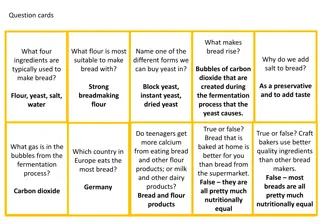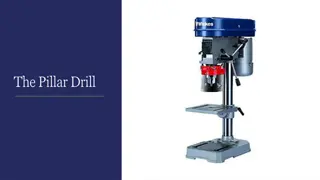Understanding Robotics: Everything You Need To Know
Robotics is an interdisciplinary field integrating computer science and engineering, involving the design, construction, operation, and use of robots. It aims to design machines to assist humans, with applications in various sectors like dangerous environments, manufacturing, and beyond. The history of robotics dates back to Norbert Wiener's formulations in 1948, leading to the development of autonomous robots and their widespread applications today, from industrial tasks to space exploration. Different types of robots, including humanoid robots, serve unique purposes, showcasing the diversity and potential of robotics technology.
Download Presentation

Please find below an Image/Link to download the presentation.
The content on the website is provided AS IS for your information and personal use only. It may not be sold, licensed, or shared on other websites without obtaining consent from the author. Download presentation by click this link. If you encounter any issues during the download, it is possible that the publisher has removed the file from their server.
E N D
Presentation Transcript
Robotics Everything You Need To Know
What do we mean by Robotics? Robotics is an interdisciplinary field that integrates computer science and engineering. Robotics involves the design, construction, operation, and use of robots. The goal of robotics is to design machines that can help and assist humans. Why is Robotics important? Robotics technology influences every aspect of work and home. Robotics has the potential to positively transform lives and work practices, raise efficiency and safety levels and provide enhanced levels of service.
Application Of Robots Robots can be used in many situations and for many purposes, but today many are used in dangerous environments (including inspection of radioactive materials, bomb detection, and deactivation), manufacturing processes, or where humans cannot survive (e.g. in space, underwater, in high heat, and clean up and containment of hazardous materials and radiation). Robotic aspects environments and for many different uses. Although being very diverse in application and form, they all share three basic similarities when it comes to their construction. There are many types of robots; they are used in many different Mechanical Construction Electrical Circuit Computer Programming Code
History Of Robotics In 1948, Norbert Wiener formulated the principles of cybernetics, the basis of practical robotics. Fully autonomous robots only appeared in the second half of the 20th century. The first digitally operated and programmable robot, the Unimate, was installed in 1961 to lift hot pieces of metal from a die casting machine and stack them. Commercial and industrial robots are widespread today and used to perform jobs more cheaply, more accurately, and more reliably than humans. They are also employed in some jobs which are too dirty, dangerous, or dull to be suitable for humans. Robots are widely used in manufacturing, assembly, packing and packaging, mining, transport, earth and space exploration, surgery, weaponry, laboratory research, safety, and the mass production of consumer and industrial goods.
Types of Robots Mechanical bots come in all shapes and sizes to efficiently carry out the task for which they are designed. From the 0.2 millimeter- long RoboBee to the 200 meter-long robotic shipping vessel Vindskip, robots are emerging to carry out tasks that humans simply can t. Generally, there are five types of robots: Pre-Programmed Robots Pre-programmed robots operate in a controlled environment where they do simple, monotonous tasks. An example of a pre- programmed robot would be a mechanical arm on an automotive assembly line. The arm serves one function to weld a door on, to insert a certain part into the engine, etc. and its job is to perform that task longer, faster, and more efficiently than a human.
Humanoid Robots Humanoid robots are robots that look like and/or mimic human behavior. These robots usually perform human-like activities (like running, jumping and carrying objects), and are sometimes designed to look like us, even having human faces and expressions. Two of the most prominent examples of humanoid robots are Hanson Robotics Sophia (in the video above) and Boston Dynamics Atlas. Autonomous Robots Autonomous robots operate independently of human operators. These robots are usually designed to carry out tasks in open environments that do not require human supervision. An example of an autonomous robot would be the Roomba vacuum cleaner, which uses sensors to roam throughout a home freely.
Teleoperated Robots Teleoperated robots are mechanical bots controlled by humans. These robots usually work in extreme geographical conditions, weather, circumstances, etc. Examples of teleoperated robots are the human-controlled submarines used to fix underwater pipe leaks during the BP oil spill or drones used to detect landmines on a battlefield. Augmenting Robots Augmenting robots either enhance current human capabilities or replace the capabilities a human may have lost. Some examples of augmenting robots are robotic prosthetic limbs or exoskeletons used to lift hefty weights.
Components Of a Robots Power Supply Actuators Electric motors (DC/AC) Sensors Controller
Power Supply The working power to the robot is provided by batteries, hydraulic, solar power, or pneumatic power sources. Actuators Actuators are the energy conversion device used inside a robot. The major function of actuators is to convert energy into movement. Electric motors (DC/AC) Motors are electromechanical component used for converting electrical energy into its equivalent mechanical energy. In robots motors are used for providing rotational movement.
Sensors Sensors provide real time information on the task environment. Robots are equipped with tactile sensor it imitates the mechanical properties of touch receptors of human fingerprints and a vision sensor is used for computing the depth in the environment. Controller Controller is a part of robot that coordinates all motion of the mechanical system. It also receives an input from immediate environment through various sensors. The heart of robot's controller is a microprocessor linked with the input/output and monitoring device. The command issued by the controller activates the motion control mechanism, consisting of various controller, actuators and amplifier.
